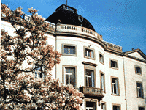Manoir d’Anjou – Rue au Bois 365

The origin of the property can be traced back to the first half of the 19th century, but the castle of Putdael as we know it today, was ordered to be built by Alfred-Casimir Madoux only in 1885. This property was transformed into a residence with the characteristics of a neo-classical castle with 3 floors and a dome above the central part, and new dependences. A-C. Madoux conceived the park with its many sculptures. Nine years after the death of Madoux, in 1913, his widow signed a 9 year lease for the castle with leisure park and two meadows, on the whole 9 ha, with the Duke of Orléans, Philippe VIII.
A bit later the Duke of Orléans bought the whole property (12 ha), the park was changed again by flowering up the roadways leading to the castle and to the pond. The undergrowth of the park was decorated by more than 1.000 plants chosen for their good adaptation to dark zones. The worn-off bridge to the island was demolished and replaced by a romantic bridge still in existence today.
The second World War lead to a new exodus by the inhabitants of the Manoir d’Anjou: the duke and the duchess of Guise, the Count and the Countess of Paris left Woluwe-Saint-Pierre and the castle was occupied by the Germans. Both the earthen paths running across the park and the old stone way which leads from the rue au Bois to the façade at the back, were asphalted. After the war, in 1948, the domain was acquired by the friars of the Good Pastor, who dedicate themselves to education. Since 1987 the Brotherhoods of the Good Pastor occupy the grounds. Nowadays, the park has an area of 5 ha. It is a private property, apart from the school buildings housing ICHEC at the entrance.
